Greenroofs.com Project of the Week: 3/28/11
Cheyenne I and III
(251 & 253 Medical Center Blvd.)
Webster, TX, USA
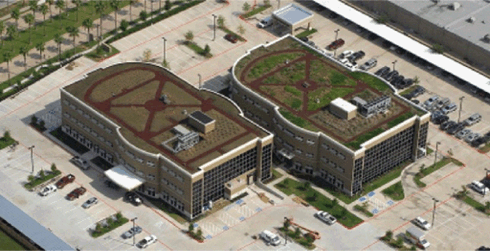
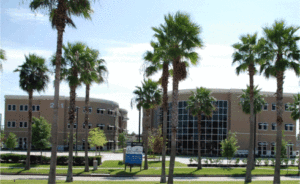 Year: 2007 & 2009
Year: 2007 & 2009
Owner: Cheyenne 1 Development Group
Location: Webster, TX, USA
Building Type:Health care
Type: Semi-Intensive
System: Custom
Size: 14,559 sq.ft. & 14,559 sq.ft
Slope: 1%
Access: Accessible, By Appointment
Project Description & Details
We’re proud to feature our first twin greenroofs as our Project(s) of the Week! Jacob White Construction Company, the developer and general contractor of the LEED Gold registered Cheyenne I (251 Medical Center Blvd.) and LEED-CS Platinum certified Cheyenne III (253 Medical Center Blvd.), wanted them to stand apart from all other commercial buildings in the Houston area. The most impressive and ambitious part of the projects were the green roofs complete with gardens, walking paths, and lush landscaped areas. In 2007, Cheyenne I was the largest green roof in Texas and possibly the entire southwest. On September 13, 2008 Hurricane Ike went across the site as a strong Category 2 hurricane with 120+ mph winds and 11 inches of rain, yet there was no impact on the green roof nor the building. In 2009, Cheyenne I got its twin located next door with Cheyenne III. The top photo above shows the newly planted and seeded Cheyenne III on the left in October, 2009.
In both cases, Webb Architects designed a custom system using EnkaRetain & Drain from Colbond with a locally designed growing media mix – the material cost savings alone was in the neighborhood of $250,000 each. Approximately 73% of all rain water is retained, while the excess (approximately 24,000 – 27,000 gallons a month for each building) is transported to the roof drains that direct it to underground cisterns for storage. That reclaimed water is used for everything from irrigating the grounds to flushing the toilets.
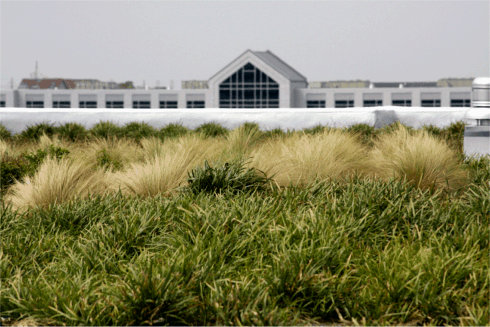
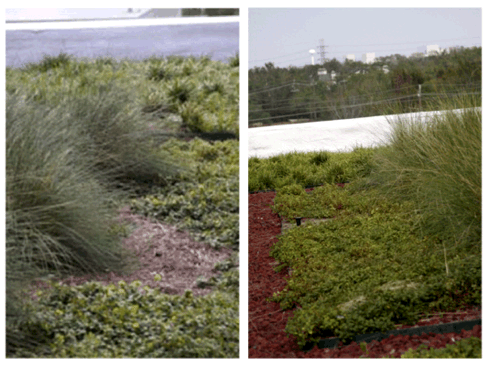
Designers/Manufacturers of Record
General Contractor: Jacob White Construction Company
Architect: Webb Architects
Engineer: BGA Engineers, Inc.
Drainage: EnkaRetain & Drain, Colbond
Because the system is custom designed, the developer estimates that by using the combination of foam board, membrane, and EnkaRetain & Drain they were able to save at least two to three weeks per project as compared to a proprietary system. Energy usage is also on track to deliver hefty savings.
Architect Joe Webb says initial power usage for the buildings is as follows:
“253: 76.29 kBtu/sf (including a controlled manufacturing area – approximately 1/3 of the second floor – that is active/running 24/7/365; 251: 73.57 kBtu/sf. 251 also incorporated temperature monitoring on the green roof since its completion. We have sensors roughly 6″ above the green roof, mid-depth of the green roof fill and at the bottom of the green roof fill just above the deck. We have seen temperatures remain extremely constant. Example: 95 ° F outside, approximately 85 to 88 ° F mid depth and roughly 80 to 82 ° F just above the deck. This means that the HVAC systems only have to make up 8 to 10 ° to maintain 72 ° F inside. Not a lot of work!”
And, water usage was as follows:
“251: the average water usage for the last 12 months is 34,500 gallons/month on 47,229 square foot of building that is 90% occupied by mostly professional medical and other professional offices. Were we irrigating with city water you could add an average 109,300 gallons/month to that number – and therefore quadruple their monthly water bill. 253: the average water usage for the last 10 months (a meter was replaced and data before that data was erratic) is 72,600 gallons/month on a 48,278 square foot office building, fully occupied, operating 14 to 16 hours a day including the controlled manufacturing area on the second floor which has significant process water use on cooling certain equipment and for their reverse osmosis system that operates 24/7/365. Again, if we were irrigating with city water you add an average 109,300 gallons/month and almost triple their water bill. You can download the calculation sheet for our green roofs’ water retention quantities for an 8″ depth roof and ours on each is more like 9″ depth.
“I also developed a set of metrics that allows me to determine the solar heat gain offset quantities for the green roof (thanks to insulating/covering the roof) in tons of HVAC capacity avoided and similarly for the evapotranspiration numbers for the roofs. Example: 253 in June has 60 tons less capacity need thanks to evapotranspiration and 71 tons less HVAC demand capacity thanks to solar radiation shielding. And we back this up with the systems downsized from 250 tons to 140 tons from 251 to 253. The buildings are operating about 40 to 55% less than his other comparable office buildings.” ~ Joe Webb
And that is exactly what the owner/developer, Jacob White Construction Company, is after – long term operating costs as they typically do not sell their buildings. Below is a graphic illustration of the twin buildings of how they’ll look after a few more seasons: Kudos to the developer for such forward thinking vision! Imagine several of these within a crowded urban environment – we could really create meaningful vegetated roof corridors that would not only manage stormwater and reduce the urban heat island effect, but also enhance local biodiversity and wildlife habitat. Speaking of which, Joe told me that Kelp Gulls are nesting on the 251 roof and have small chicks!
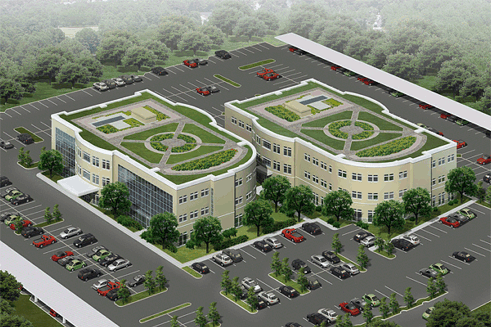
Also, as if the data wasn’t environmentally important enough, each roof removes 597 lbs. of particulate matter per year from the air and each roof generates enough oxygen for 904 people each day (5,424 lbs. of oxygen).
Did we miss something? We’d love to hear from you! Click to see more information about these projects in The International Greenroof & Greenwall Projects Database – here for Cheyenne I and here for Cheyenne III. See how you can submit yours here.
Love the Earth, Plant a Roof!
~ Linda V.
 Greenroofs.comConnecting the Planet + Living Architecture
Greenroofs.comConnecting the Planet + Living Architecture





Sky Gardens » Blog Archive » Greenroofs.com’s “This Week in Review” on GreenroofsTV: April 1st, 2011
[…] (Check out Linda’s latest Sky Gardens Blog posts: “GPW: Cheyenne I and III (251 & 253 Medical Center Blvd.)“  and my TWIR for […]